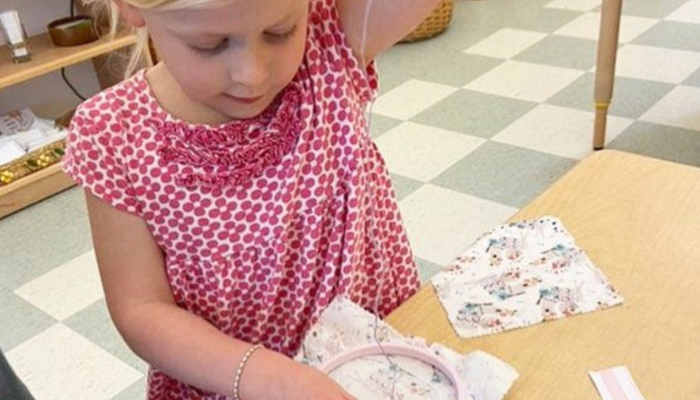By TMoM Team Member Anna Keller
“Our care of the child should be governed, not by the desire to make him learn things, but by the endeavor always to keep burning within him that light which is called intelligence.” – Maria Montessori
Our family ended up in the Montessori community unexpectedly – it was a mid-pandemic preschool switch for our daughter – and it ended up being SUCH a happy accident. Now, a year and a half later, we are completely in love with the Montessori philosophy. Our son will also be starting preschool there in August when he’s 18 months old.
I was familiar enough with the concept of a Montessori education before my daughter, Maggie, started attending her school. I knew that I liked it, but it wasn’t until she became a Montessori student and I saw it up close that I truly fell in love with this learning style.
My husband and I appreciate the heart of what Montessori is. We appreciate their end goal to “…develop students who are capable, accountable, knowledgeable people who have the strong sense of self they will need to thrive in the real world.” (American Montessori Society)
It’s common, I think, to consider Montessori as a preschool option, but it does extend beyond that in many schools. We’ll be sending our daughter to public school for kindergarten this fall. However, we are so appreciative of the foundation she received in Montessori school for preschool. We think it’s an excellent option for elementary school and beyond as well.
You may be in the same boat that I was just a few months ago. You may have Montessori on your radar and have positive feelings about it, but may not know specifics. Here are some key elements to help:
Where did it begin?
The Montessori style of teaching began with Dr. Maria Montessori in Italy in the early 1900s. Dr. Montessori was Italy’s first female doctor. She opened a center to provide education to low-income children in Rome. She deviated from standard teaching methods. Instead, she used a child-centered approach which she saw help the students gain confidence, independence, and academic growth as well.
What are some of its benefits?
I appreciate so much about the Montessori model, but some of the benefits that rise to the top for me are:
- Developing independence
- Solidifying a community mindset
- Discovering a lifelong love of learning
- Individually paced learning
- Building critical thinking skills
Montessori students are encouraged to do things independently often – and starting at a young age – to really build confidence, concentration, and purpose. We were so impressed at the skills and pride our daughter developed within this model.
What are some big differences between Montessori and other learning styles?
- Self-guided learning (within limits, students have a say on what their learning focus will be at a given point, which helps them keep a love of learning)
- Learning through ownership of common tasks (students participate in activities like watering flowers, washing clothes, preparing food, sweeping, and more to develop fine motor skills while they learn to be curious about the world around them and how it works)
- An environment more like a family than a typical classroom (everyone is responsible for the classroom – the teachers don’t “own” the classroom and are known as guides – and community is at the heart of the way the school functions)
- Independence is paramount (students are constantly given opportunities to self regulate when it comes to themselves and their learning)
Montessori toys are definitely having a moment, too, when you look at the landscape! If you’re interested in what a “Montessori toy” means and why to consider bringing some into your home, check out this article I wrote for Zulily’s blog on that topic.
Want to see more blogs like this and get notifications on local events and happenings? Subscribe to our free weekly newsletters here.
















